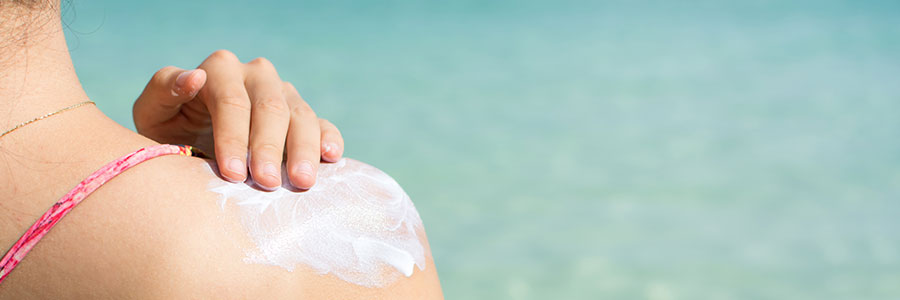
The sun is out year-round in southern California, and the diligent use of sunscreen is a must!
WHY USE SUNSCREEN?
Sunscreen helps protect the skin from the sun’s ultraviolet (UV) radiation by absorbing or reflecting it. There are two types of UV radiation – UVA and UVB. UVA causes wrinkling and aging, and UVB causes sunburns. Both types can cause skin cancer.
Don’t believe the myths that you don’t need sunscreen if you have darker skin or that getting a base tan prevents sunburn and skin cancer. All types of skin are susceptible to the disease.
WHICH SUNSCREEN IS RIGHT FOR YOU?
SPF stands for “sun protection factor,” and it is a measure of how long it would take for a sunburn to occur from UVB rays. For example, if your unprotected skin would burn in 10 minutes, using sunscreen with an SPF of 15 would prevent reddening 15 times longer, for 150 minutes.
Another way to calculate the SPF benefit is in terms of percentages: SPF 15 filters out approximately 93%-94% of all UVB rays, SPF 30 filters out 97%, and SPF 50 filters out 98%.
You should note that the protection that is calculated based on these SPF levels is based on thorough, not thin, coverage of the sunscreen on your body.
Are the sunscreens with higher SPFs better? Yes, especially if you have fair skin or a history of skin cancer, or if you spend considerable time outside. But you should be aware that no sunscreen provides 100% protection.
Note that a “broad-spectrum” sunscreen provides protection against both UVA and UVB rays. Check the label because many sunscreens do not protect against UVA rays. If you are unsure of the best brands to purchase, the Skin Cancer Foundation provides a list of sunscreens that it recommends.
USING THE SUNSCREEN
Even though sunscreen should be used year-round and in all types of weather, it is even more important during the summer to understand its proper use and follow these steps:
- Apply the sunscreen approximately 30 minutes prior to sun exposure.
- It is imperative that you apply all types of sunscreens thoroughly to cover your body.
- For lotions, you should apply at least one ounce.
- For sprays, cover your entire skin and rub it in. Avoid spraying yourself in a windy area, which could cause the sunscreen to end up in the air rather than on your body.
- It is recommended that you re-apply the same amount every two hours, or immediately after swimming, drying/toweling off, or sweating, even if you are using a water-resistant sunscreen.
OTHER WAYS TO PROTECT YOUR SKIN
In addition to using sunscreen, you can protect your skin in other ways:
- Stay in the shade as much as possible, especially between 10:00 a.m. and 4:00 p.m.
- Wear sun-protective clothing with a high ultraviolet protection factor (UPF) – check the label for the clothing’s rating.
- Wear loose-fitting clothing with tightly woven fabric.
- Wear a hat with a wide enough rim to cover your ears and neck.
- Wear UV-blocking sunglasses.
HOW TO TREAT SUNBURNS
If you do suffer a mild sunburn, the following steps may ease your discomfort:
- Drink plenty of fluids such as water or sports drinks in case you are dehydrated.
- Use a light moisturizer or aloe vera lotion.
- Take acetaminophen, ibuprofen, or aspirin if you have a headache or fever, if permitted by a physician.
- Take a cool bath or shower.
- Seek medical attention for severe sunburns.
If you have any questions or concerns about your skin care or skin cancer, please visit our office and we’ll be happy to help you!
The content provided in our website blogs is offered for informational purposes only, and it should not be considered as the practice of medicine or medical advice regarding the diagnosis or treatment of any medical condition or disease. You should consult with a medical professional if you have any questions regarding a condition or disease in relation to your specific healthcare needs. If you feel that you are experiencing a medical emergency, please contact 911 immediately.

